
By Sandra Brooke, Florida State University,
Peter Etnoyer, NOAA National Centers for Coastal Ocean Science,
Heather Coleman, NOAA Deep Sea Coral Research and Technology Program
August 16, 2017
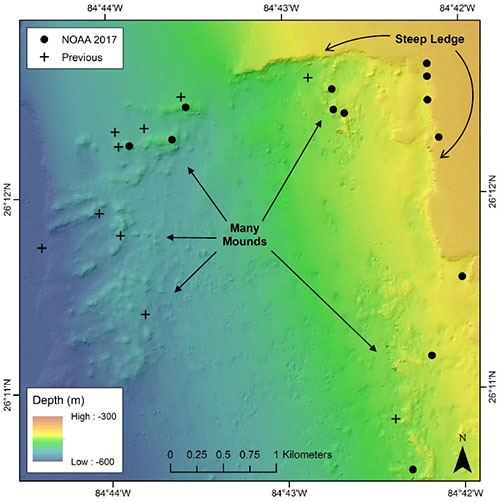
Map showing topography and remotely operated vehicle (ROV) dives within the Many Mounds site on the West Florida slope (see the mission plan map for site context). Color indicates depth, with orange showing the major ledge feature at about 400 meters and blue leading deeper. Crosses indicate previous ROV dive start points, and dots show waypoints of four dives with ROV Odysseus, operated by Pelagic Research Services, and launched from NOAA Ship Nancy Foster in August 2017. The illustrated area covers approximately half of the area proposed as a Habitat Area of Particular Concern. Image courtesy of Matt Poti, NOAA National Centers for Coastal Ocean Science. Download larger version (jpg, 339 KB).
The deep sea in the northern Gulf of Mexico is relatively well-explored due to oil and gas interests. However, a moratorium in the eastern Gulf limited commercial exploration off the coast of Florida, where NOAA and university researchers are surveying promising areas of deep coral habitat. The most extensively visited section of the West Florida slope had seen 10 remotely operated vehicle (ROV) and submersible dives before our current mission. We call this site “Many Mounds.”
West Florida slope surveys in 2008 mapped an extensive ledge at about 400 meters depth. This seafloor feature and strong currents support what may be one of the most extensive deep reef habitats in the Gulf.
Just off the ledge, between about 500-700 meters, small and large mounds had previously been observed dotting the seafloor-like rolling hills with dense communities of corals and sponges. One of the most prominent reef-building stony corals, Lophelia pertusa, creates the structure on these mounds that supports diverse assemblages of invertebrates and fishes, some of which are economically valuable. The unexplored ledge and fields of Lophelia enticed us to better understand this area.
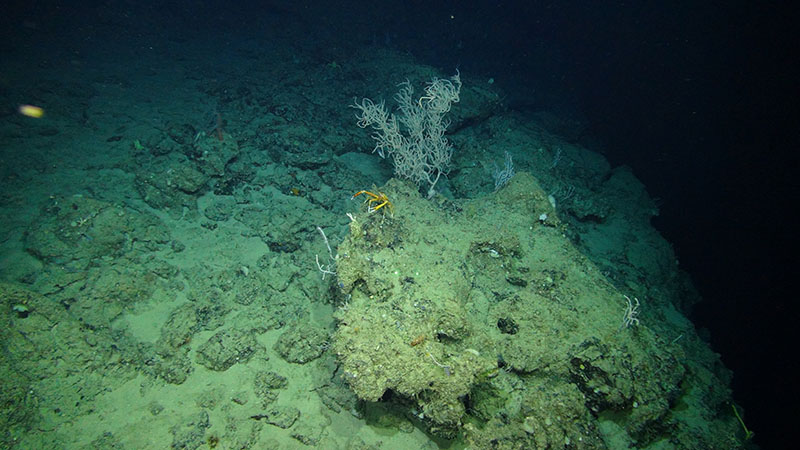
The ledge feature of Many Mounds, on the West Florida slope, inhabited by black coral (black corals often appear white or orange but are named for the color of their skeletons), squat lobsters, and small octocorals. Image courtesy of NOAA Southeast Deep Coral Initiative and Pelagic Research Services. Download larger version (jpg, 9.4 MB).
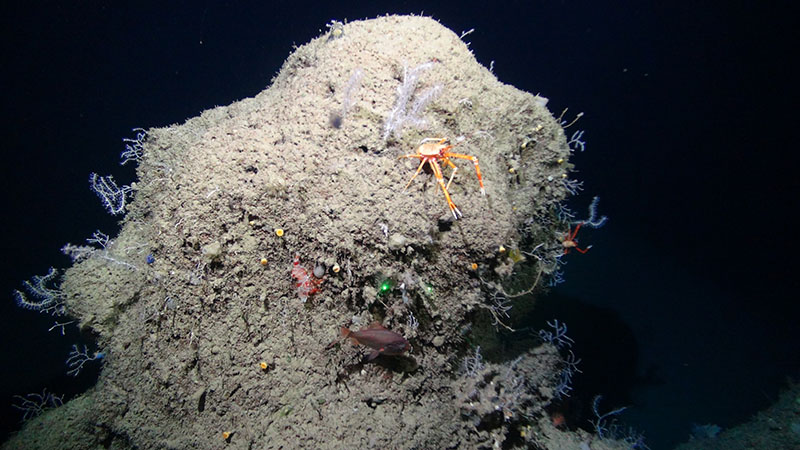
Squat lobsters and small octocorals as well as shrimp, cup corals, and Darwin’s slimehead fish seen on the ledge feature of Many Mounds. Image courtesy of NOAA Southeast Deep Coral Initiative and Pelagic Research Services. Download larger version (jpg, 8.5 MB).
We have come to Many Mounds today to document its coral communities and to collect samples that will help us understand aspects of Lophelia and black coral growth, reproduction, and genetic linkages. It is a great place to sample corals and sponges given their abundance and the theory that current flows may send larvae from West Florida into the Gulf Stream and beyond. We still have a lot to learn about how far larvae are transported and how different populations are connected – these are some of our goals for this mission.
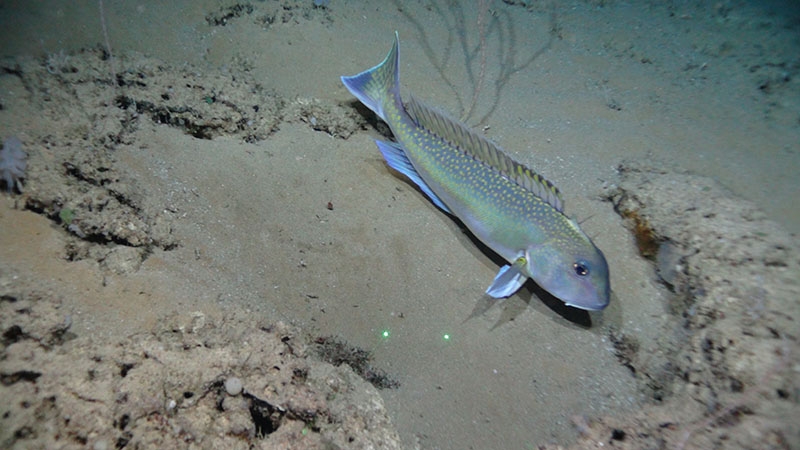
Golden tilefish seen on the ledge feature at Many Mounds. Image courtesy of NOAA Southeast Deep Coral Initiative and Pelagic Research Services. Download larger version (jpg, 8.5 MB).
Our dive on Many Mounds today explored two habitat types dominated by coral communities. The steep ledge feature harbors iconic species of Leiopathes glaberrima black coral, sea fans, and sea whips, as well as fish including golden tilefish, blackbelly rosefish, and Darwin’s slimehead. On the mounds, Lophelia colonies are expansive and interspersed with more black corals, sea fans, and lace corals. Squat lobsters and sponges are everywhere.
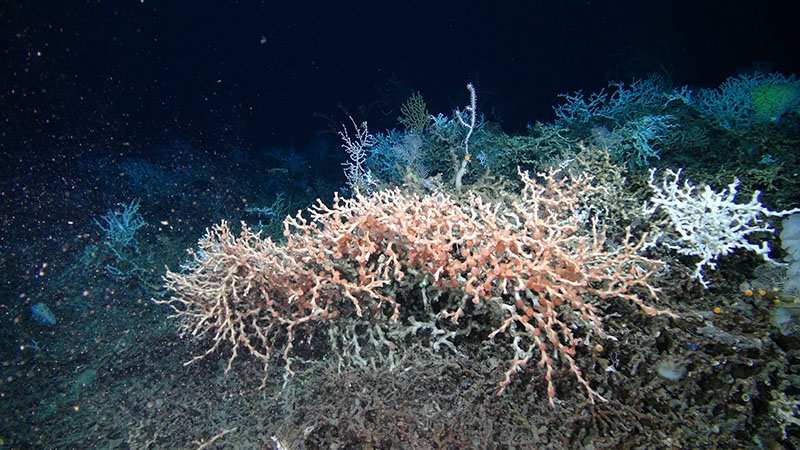
A rare sighting of orange Lophelia pertusa located at 500 meters depth at Many Mounds on the West Florida slope. The vast majority of L. pertusa in North American waters are stark white, like the colony to the right in this image. Image courtesy of NOAA Southeast Deep Coral Initiative and Pelagic Research Services. Download larger version (jpg, 10.1 MB).
One of the most exciting discoveries at Many Mounds was finding an orange colony of Lophelia, which is common in the eastern Atlantic but extremely rare in the western hemisphere (fewer than five known sightings). We were thrilled to see this rare and beautiful coral variety, but its discovery raised more questions: where did the original larva come from, and why is there only one orange colony when all the others are white?
Based on numerous coral observations, the Many Mounds area is under consideration for protection as a Habitat Area of Particular Concern (HAPC) by the Gulf of Mexico Fishery Management Council. One aspect of this mission is to provide a more complete site description, including high-resolution maps, data, and images. If the Council designates Many Mounds as an HAPC, bottom-contact fishing gear use may be limited, providing vulnerable coral with some protection from human activities.
The expedition is supported by NOAA’s Deep Sea Coral Research and Technology Program through the Southeast Deep Coral Initiative (SEDCI), a multi-disciplinary effort that will study deep-sea coral ecosystems across the Southeast United States in 2016-2019.